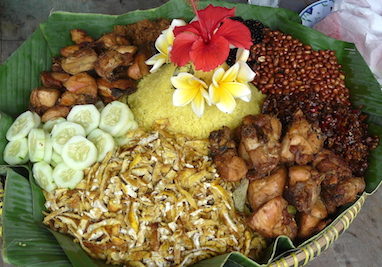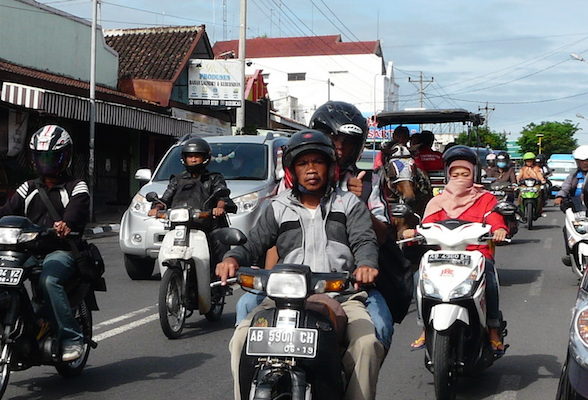It was the very first question that a young, handsome man asked me on a sunny Indonesian morning one and a half decade ago. This man became my husband 4 years later. It was also the second question that his father, my late father-in-law asked me as I met him the first time. And it is the question that belongs to the top 5 of my “The most frequent questions that Indonesians ask expats”- list. It is … drumroll … the question, “Udah bisa makan nasi?” – “Can you already eat rice?”
For many years, I had wondered why on earth Indonesians ask me that. And why they ask me that at the very beginning? Do they think that rice is a strange dish for foreigners? Or that this white, plain tasting grain is hard to eat or like? I mean, nasi (rice) doesn´t belong to those “exotic” Indonesian dishes that are well known to not meet the taste of foreigner´s tongues like Swike Asam Manis (Sweet-sour Frog), Kepala Ayam Goreng (Fried Chicken Head) or Sate Usus (Chicken Intestine Stick). Remembering the variety of rice types ranging from American long grain rice, Indian Basmati rice or Japanese Sushi rice (just to mention a few) I assumed that people are aware of the fact that rice is popular almost everywhere in the world.
CULTURAL KNOWLEDGE INDONESIA SERIES
This is another article of the CULTURAL KNOWLEDGE INDONESIA SERIES. In this blog, I discuss regularly cultural concepts of Indonesia as well as weird, funny or critical cross-cultural situations between expats and Indonesians. Stay tuned!
So, what´s their point when Indonesians ask foreigners if they “already can eat rice”? To understand this, we need to do something that is most important when dealing with people from another culture: Trying to see the things with the eyes of them, in this case the Indonesians. That´s why I think instead of wondering about that question it´s better to find out what “eating rice” actually means to them.
Yep, what does it mean? Honestly, it took me some years to become really clear of the significance that is carried in this topic. It is not only about eating habits but tells us a world about everyday life and food culture in the island country.
“If we haven´t eaten rice yet, then to us it is like we haven´t eaten at all this day.”
Makan nasi means eating rice everyday up to 3 times
When people from i.e. European countries say that they eat rice they mean that they basically eat it. Sometimes a Risotto or a Paella or just an ordinary rice dish twice to three times a week. When Indonesians say that they eat rice, they mean that they eat it EVERYDAY. Everyday UP TO 3 TIMES, for breakfast, lunch and dinner!
Indonesians no matter from which island, from child to grandma, from day-worker to company leader admit to one popular saying: “If we haven´t eaten rice yet, then to us it is like we haven´t eaten at all this day.” Although they had a slice of bread or some noodles before, as long as Indonesians haven´t swallowed rice they feel like their stomach is still empty.
That´s why it is no surprise that rice is the staple food No. 1 in Indonesia. It mostly comes along as nasi putih (white rice) but since people have become aware of it´s negative impact on the blood sugar level more and more often also as nasi merah (red or wild rice). Rice is cooked in coconut milk as nasi uduk or by using turmeric made to nasi kuning (yellow rice) at celebrations (see pic below). People steam rice in banana leave rolls (lontong) or in woven coconut leave packets to make ketupat. As you can see, rice serves as dish in any imaginable shape and so also as bubur (porridge) or kerupuk (cracker). Rice is everywhere.
Makan nasi means having a meal
Getting back to this popular saying above, we can see that makan nasi (literally: eat rice) does not only mean to eat rice as a dish or from time to time. No it rather means, “having a meal at all”. My neighbor in my kampung in Jogja who is an elderly man that loves making jokes in Javanese (and challenging my limited knowledge in this language) asks me every time he meets me in his husky voice “Wis ngliwet urung?” (Have you already cooked [rice] or not yet?) Ngliwet means “cooking rice” but is used as a synonym for “cooking rice with vegetable tofu or tempe* or meat, sambal* and kerupuk” in daily life. So, if somebody tells you that he wants to eat rice, he tells you to simply have a complete meal. Regardless the fact that noodle dishes should have also the right to be considered as meal in my opinion, but anyway…
* Tempe is fermented soybean served as slices or cubes. Sambal is more or less spicy red or green chili sauce.
To summarize it: Makan nasi means indeed eating rice but rather “eating rice everyday up to 3 times” and “eating a whole meal including nasi and many other yummy things…” This image of food reality is what Indonesians have in mind when asking you the nasi-question.
Realizing this, I understood why over the years so many people have brought up that question. It was just hard to believe that a foreigner does makan nasi in such a frequent way (which in my case was indeed true).
And there is one more…
Another reason why Indonesians ask foreigners the “Udah bisa makan nasi”-question might be pure empathy. They imagine how it would feel to live like you in a country where a foreign food stands so much out in everyday culinary life that they had no choice than to adapt to it. They want to find out if it is difficult for you to let go from your bread/potato/noodle food culture. Is it hard or easy for you to accept having rice all the time? And actually they also mean either “Do you like it?” or “Are you as happy as us eating rice all the time?”
So? Do you like it? And if yes, in which shape and with what side dishes? Most interesting for me is to know – have you also been asked the “Udah bisa makan nasi”-question? I´m wondering if this also happens to foreigners in other parts of Indonesia… Let me know by leaving a comment below! I´d be very happy to read from you.
If you feel that this topic needs to be read by your friends, please don´t forget to share this article and give me thumbs. Thank you!
Stay connected with Culturenergy! Like my page on Facebook and follow me on Instagram!





 Just
Just